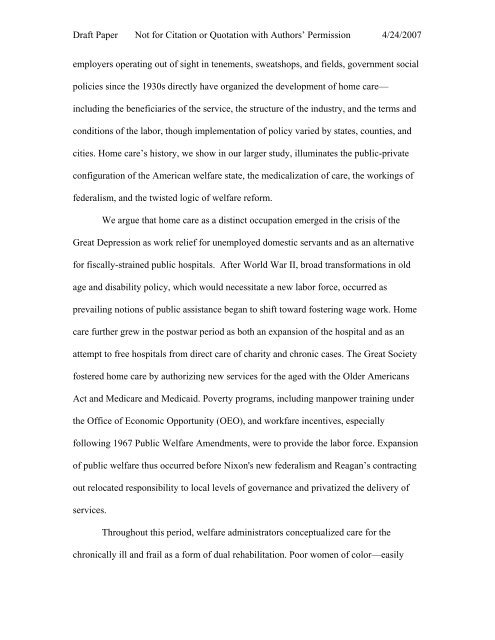Organizing Home Care: - School of Social Service Administration
Organizing Home Care: - School of Social Service Administration
Organizing Home Care: - School of Social Service Administration
Create successful ePaper yourself
Turn your PDF publications into a flip-book with our unique Google optimized e-Paper software.
Draft Paper Not for Citation or Quotation with Authors’ Permission 4/24/2007<br />
employers operating out <strong>of</strong> sight in tenements, sweatshops, and fields, government social<br />
policies since the 1930s directly have organized the development <strong>of</strong> home care—<br />
including the beneficiaries <strong>of</strong> the service, the structure <strong>of</strong> the industry, and the terms and<br />
conditions <strong>of</strong> the labor, though implementation <strong>of</strong> policy varied by states, counties, and<br />
cities. <strong>Home</strong> care’s history, we show in our larger study, illuminates the public-private<br />
configuration <strong>of</strong> the American welfare state, the medicalization <strong>of</strong> care, the workings <strong>of</strong><br />
federalism, and the twisted logic <strong>of</strong> welfare reform.<br />
We argue that home care as a distinct occupation emerged in the crisis <strong>of</strong> the<br />
Great Depression as work relief for unemployed domestic servants and as an alternative<br />
for fiscally-strained public hospitals. After World War II, broad transformations in old<br />
age and disability policy, which would necessitate a new labor force, occurred as<br />
prevailing notions <strong>of</strong> public assistance began to shift toward fostering wage work. <strong>Home</strong><br />
care further grew in the postwar period as both an expansion <strong>of</strong> the hospital and as an<br />
attempt to free hospitals from direct care <strong>of</strong> charity and chronic cases. The Great Society<br />
fostered home care by authorizing new services for the aged with the Older Americans<br />
Act and Medicare and Medicaid. Poverty programs, including manpower training under<br />
the Office <strong>of</strong> Economic Opportunity (OEO), and workfare incentives, especially<br />
following 1967 Public Welfare Amendments, were to provide the labor force. Expansion<br />
<strong>of</strong> public welfare thus occurred before Nixon's new federalism and Reagan’s contracting<br />
out relocated responsibility to local levels <strong>of</strong> governance and privatized the delivery <strong>of</strong><br />
services.<br />
Throughout this period, welfare administrators conceptualized care for the<br />
chronically ill and frail as a form <strong>of</strong> dual rehabilitation. Poor women <strong>of</strong> color—easily
















